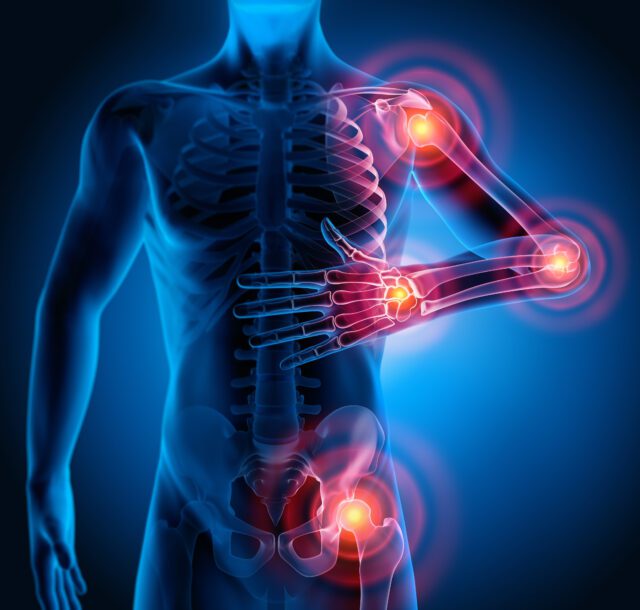Have you noticed pain, swelling, and/or stiffness in your joints? Those symptoms could be signs of arthritis, an inflammation of the joints. So, how do you know if you’re at risk for developing arthritis? What are the different types of arthritis? And what can you do to ease arthritis pain – or even possibly prevent it? Keep reading for answers to all of those questions and more.
Types of Arthritis
There are many types of arthritis. The condition especially affects joints, tendons, ligaments, bones and muscles. Some of the common ones are osteoarthritis, fibromyalgia, gout, rheumatoid arthritis and systemic lupus erythematosus (SLE). In osteoarthritis, the cartilage on weight-bearing joints breaks down and may wear away completely. Cartilage, which consists of a dense network of collagen and elastic fibers, is the part of the joint that cushions the ends of bones. Cartilage breakdown causes bones to rub against each other, resulting in joint pain and stiffness.
Fibromyalgia is a chronic disorder that causes pain throughout the muscles, joints, ligaments and tendons that support and move the bones and joints. The pain occurs in localized areas, particularly in the spine, shoulders, front of the knees, elbows, hip joints and around the neck. Besides pain, patients may also expe- rience fatigue and sleep disturbances.
Gout is caused by deposits of uric acid crystals in the joints that cause inflammation, swelling, and pain.
Rheumatoid arthritis and SLE are autoimmune disorders; that is, the body’s own immune system is damaged and starts to attack its own healthy cells and tissues. Rheumatoid arthritis is an inflammatory disease of the lining of the joint, especially in the hands and feet. The inflammation occurs equally on both sides of the body and this symmetry helps to distinguish it from other forms of arthritis. Apart from damage to the joints, the faulty immune system that results from SLE can also harm the skin, kidneys, heart, lungs, blood vessels, and brain.
Risk Factors
Some risk factors have been identified and are known to increase the chances of developing arthritis. The excessive use of the joint from repeated injury due to sports, work-related activity or accidents may put you at increased risk for developing osteoarthritis. Family history plays a role in increasing susceptibility to gout and it is believed that the combination of genetic, gender (more women than men) and environmental factors are its possible triggers and that of rheumatoid arthritis as well. Weight management is important to avoid putting extra pressure on affected joints, which can aggravate many types of arthritis.
Treatment and Prevention
A well-balanced diet low in saturated fat, along with regular exercise, will ensure healthy body weight, reduced joint pain and stiffness, and increased flexibility, muscle strength, and endurance. Saturated fats are to be avoided as they increase production of inflammatory chemical compounds (cytokines) that aggravate swelling, redness, and pain. Unsaturated fatty acids, especially omega-3 fatty acids, have consistently shown to reduce morning stiffness and tender joints as these suppress production of pro-inflammatory cytokines and cartilage damaging enzymes.
Positive results were obtained with nine to 18 capsules of fish oil (1,000mg) daily for four months or more in the treatment of rheumatoid arthritis. Researchers view fish oils as an important complementary dietary component to the successful treatment of joint diseases.
Arthritis is a common condition that affects millions of people around the world. But by knowing the risk factors, you can take steps to treat it and possibly prevent it from hindering your health and life.
Insider’s Health Exclusive –>>: Click Here to Find out about “Triple Action Pain Relief” that naturally reduces muscle and joint pain in minutes. (No one knows about it yet)









